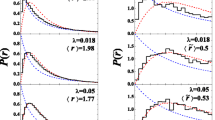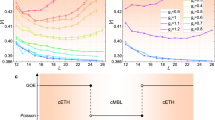Abstract
We employ the power-law random banded matrix (PRBM) ensemble with single tuning parameter \(\mu \) as the effective model for many-body localization (MBL) transition in random spin systems. We show the PRBM accurately reproduces the eigenvalue statistics on the entire phase diagram through the fittings of high-order spacing ratio distributions \(P(r^{(n)})\) as well as number variance \(\Sigma ^{2}(l)\), in systems both with and without time-reversal symmetry. For the properties of eigenvectors, it’s shown the entanglement entropy of PRBM displays an evolution from volume-law to area-law behavior which signatures an ergodic–MBL transition, and the critical exponent is found to be \(\nu =0.83\pm 0.15\), close to the value obtained in 1D physical model by exact diagonalization, while the computational cost here is much less.




Similar content being viewed by others
Data Availability
This manuscript has associated data in a data repository. [Authors’ comment: The data that support the figures within this paper are available from the corresponding author upon reasonable request.]
References
I.V. Gornyi, A.D. Mirlin, D.G. Polyakov, Phys. Rev. Lett. 95, 206603 (2005)
I.V. Gornyi, A.D. Mirlin, D.G. Polyakov, Phys. Rev. Lett. 95, 046404 (2005)
D.M. Basko, I.L. Aleiner, B.L. Altshuler, Ann. Phys. 321, 1126 (2006)
J.A. Kjall, J.H. Bardarson, F. Pollmann, Phys. Rev. Lett. 113, 107204 (2014)
Z.C. Yang, C. Chamon, A. Hamma, E.R. Mucciolo, Phys. Rev. Lett. 115, 267206 (2015)
M. Serbyn, A.A. Michailidis, M.A. Abanin, Z. Papic, Phys. Rev. Lett. 117, 160601 (2016)
J. Gray, S. Bose, A. Bayat, Phys. Rev. B 97, 201105 (2018)
M. Serbyn, Z. Papić, D.A. Abanin, Phys. Rev. X 5, 041047 (2015)
H. Kim, D.A. Huse, Phys. Rev. Lett. 111, 127205 (2013)
M. Znidaric, T. Prosen, P. Prelovsek, Phys. Rev. B 77, 064426 (2008)
J.H. Bardarson, F. Pollman, J.E. Moore, Phys. Rev. Lett. 109, 017202 (2012)
M. Serbyn, Z. Papić, D.A. Abanin, Phys. Rev. B 90, 174302 (2014)
V. Oganesyan, D.A. Huse, Phys. Rev. B 75, 155111 (2007)
Y. Avishai, J. Richert, R. Berkovits, Phys. Rev. B 66, 052416 (2002)
N. Regnault, R. Nandkishore, Phys. Rev. B 93, 104203 (2016)
S.D. Geraedts, R. Nandkishore, N. Regnault, Phys. Rev. B 93, 174202 (2016)
V. Oganesyan, A. Pal, D.A. Huse, Phys. Rev. B 80, 115104 (2009)
A. Pal, D.A. Huse, Phys. Rev. B 82, 174411 (2010)
S. Iyer, V. Oganesyan, G. Refael, D.A. Huse, Phys. Rev. B 87, 134202 (2013)
D.J. Luitz, N. Laflorencie, F. Alet, Phys. Rev. B 91, 081103(R) (2015)
C.L. Bertrand, A.M. García-García, Phys. Rev. B 94, 144201 (2016)
M.L. Mehta, Random Matrix Theory (Springer, New York, 1990)
F. Haake, Quantum Signatures of Chaos, (Springer 2001)
P. Shukla, New J. Phys. 18, 021004 (2016)
M. Serbyn, J.E. Moore, Phys. Rev. B 93, 041424(R) (2016)
E.B. Bogomolny, U. Gerland, C. Schmit, Eur. Phys. J. B 19, 121 (2001)
W.-J. Rao, J. Phys. A: Math. Theor. 54, 105001 (2021)
W.-J. Rao, Physica A: Statistical Mech Appl 590, 126689 (2022)
P. Sierant, J. Zakrzewski, Phys. Rev. B 99, 104205 (2019)
W. Buijsman, V. Cheianov, V. Gritsev, Phys. Rev. Lett. 122, 180601 (2019)
P. Sierant, J. Zakrzewski, Phys. Rev. B 101, 104201 (2020)
A.D. Mirlin, Y.V. Fyodorov, F.-M. Dittes, J. Quezada, T.H. Seligman, Phys. Rev. E 54, 3221 (1996)
F. Evers, A.D. Mirlin, Phys. Rev. Lett. 84, 3690 (2000)
A.D. Mirlin, F. Evers, Phys. Rev. B 62, 7920 (2000)
F. Evers, A.D. Mirlin, Rev. Mod. Phys. 80, 1355 (2008)
V.E. Kravtsov, K.A. Muttalib, Phys. Rev. Lett. 79, 1913 (1997)
J.A. Méndez-Bermúdez, A. Alcazar-López, I. Varga, EPL 98, 37006 (2012)
J. A. Méndez-Bermúdez, A. Alcazar-López, I. Varga, J. Stat. Mech. p. 11012 (2014)
I. Varga, Phys. Rev. B 66, 094201 (2002)
J.A. Méndez-Bermúdez, I. Varga, Phys. Rev. B 74, 125114 (2006)
I. Varga, D. Braun, Phys. Rev. B 61, 11859 (2000)
X. Cao, A. Rosso, J.-P. Bouchaud, P. Le Doussal, Phys. Rev. E 95, 062118 (2017)
V. Khemani, D.N. Sheng, D.A. Huse, Phys. Rev. Lett. 119, 075702 (2017)
M. Carrera-Núñez, A.M. Martínez-Argüello, J.A. Méndez-Bermúdez, Physica A: Statistical Mech. Appl. 573, 125965 (2021)
Y.Y. Atas, E. Bogomolny, O. Giraud, G. Roux, Phys. Rev. Lett. 110, 084101 (2013)
S.H. Tekur, U.T. Bhosale, M.S. Santhanam, Phys. Rev. B 98, 104305 (2018)
W.-J. Rao, Phys. Rev. B 102, 054202 (2020)
J.M.G. Gomez, R.A. Molina, A. Relano, J. Retamosa, Phys. Rev. E 66, 036209 (2002)
F. Alet, N. Laflorencie, C. R. Physique 19, 498–525 (2018)
P. Shukla, Phys. Rev. E 62, 2098 (2000)
P. Shukla, Phys. Rev. E 75, 051113 (2007)
D.N. Page, Phys. Rev. Lett. 71, 1291 (1993)
L. Rademaker, M. Ortuño, Phys. Rev. Lett. 116, 010404 (2016)
C. Monthus, Journal of Physics A: Mathematical and Theoretical 49, 305002 (2016)
S.J. Thomson, M. Schiró, Phys. Rev. B 97, 060201(R) (2018)
D. Pekker, B.K. Clark, V. Oganesyan, G. Refael, Phys. Rev. Lett. 119, 075701 (2017)
B. Bauer, C. Nayak, J. Stat. Mech. p. 09005 (2013)
D.E. Logan, S. Welsh, Phys. Rev. B 99, 045131 (2019)
T. Papenbrock, Z. Pluhař, J. Tithof, H.A. Weidenmüller, Phys. Rev. E 83, 031130 (2011)
S. Pai, N.S. Srivatsa, A.E.B. Nielsen, Phys. Rev. B 102, 035117 (2020)
M. Haque, P. A. McClarty, I. M. Khaymovich, arXiv:2008.12782
G. De Tomasi, I.M. Khaymovich, F. Pollmann, S. Warzel, Phys. Rev. B 104, 024202 (2021)
E. Bogomolny, M. Sieber, Phys. Rev. E 98, 042116 (2018)
P. Nosov, I.M. Khaymovich, V.E. Kravtsov, Phys. Rev. B 99, 104203 (2019)
G. De Tomasi, I.M. Khaymovich, Phys. Rev. Lett. 124, 200602 (2020)
S.-X. Zhang, H. Yao, Phys. Rev. Lett. 121, 206601 (2018)
Acknowledgements
The author acknowledges M. Haque and I. Khaymovich for stimulating and helpful discussions. This work is supported by the National Natural Science Foundation of China through Grant No. 11904069.
Author information
Authors and Affiliations
Corresponding author
Appendix A: Fitting spin models without \(S_{T}^{z}\) conservation
Appendix A: Fitting spin models without \(S_{T}^{z}\) conservation
In this section we use PRBM to fit the eigenvalue statistics of random spin models without \(S_{T}^{z}\) conservation; the Hamiltonian is as follows
The distributions of \(P(r^{(n)})\) in the orthogonal spin model without \(S_T^z\) conservation with comparisons to PRBM, the title of each sub-figure indicates the randomness strength h and fitted \(\mu \). Bottom right: \(\Sigma ^2(l)\) of the physical model and PRBM with \(\mu \) fitted through \(P(r^{(n)})\), they fit quite well except for the transition region \(h\sim 3\). Grey dashed line: \(\Sigma ^2(l)\) of PRBM at \(\mu =1.26 \). Dots and lines stand for physical data and PRBM in all cases
The distributions of \(P(r^{(n)})\) in the unitary spin model without \(S_T^z\) conservation at various disorder strengths with comparisons to PRBM with \(\beta =2\) and fitted \(\mu \). Bottom right: \(\Sigma ^2(l)\) of physical model and PRBM. Note here the values of \(\mu \) are fitted by \(\Sigma ^2(l)\) as listed in the figure legend; they have minor deviations from those fitted through \(P(r^{(n)})\), but the relative errors are controlled within 5%. Dots and lines stand for physical data and PRBM in all cases
We will also consider the cases both with and without time-reversal symmetry. For the former, it is the case with \(h^{x}=h^{z}=h\ne 0\) and \( h^{y}=0\), while for the latter, it is \(h^{x}=h^{y}=h^{z}=h\ne 0\). For both models we simulate an \(L=13\) system, with Hilbert space dimension \( 2^{13}=8192\). In all cases, the number of eigenvalue spectrum samples is 400, and we take 400 eigenvalues in the middle to determine \(P\left( r^{\left( n\right) }\right) \).
For the orthogonal case, we likewise take several representative randomness strengths to determine spacing ratio distributions \(P\left( r^{\left( n\right) }\right) \) and number variance \(\Sigma ^{2}\left( l\right) \), and compare them to those of orthogonal PRBM with \(\beta =1\), and the results are collected in Fig. 5. This model suffers less from finite-size effect; hence, the fittings are close to perfect. Moreover, the optimal parameter \(\mu \) fitted by \(P\left( r^{\left( n\right) }\right) \) and \(\Sigma ^{2}\left( l\right) \) is very close in most of the phase diagram, except for the transition region \(h\sim 3\), as can be viewed from the last sub-figure of Fig. 5.
For the time-reversal breaking case with \(h^{x}=h^{y}=h^{z}=h\), the fitting results are displayed in Fig. 6. The finite size effects are slightly larger than the orthogonal case, just like in the models with \( S_T^z \) conservation as discussed in the main text. Nevertheless, the deviations between the values of \(\mu \) fitted by \(P\left( r^{\left( n\right) }\right) \) and \(\Sigma ^{2}\left( l\right) \) are still less than 5%.
Rights and permissions
About this article
Cite this article
Rao, WJ. Power-law random banded matrix ensemble as the effective model for many-body localization transition. Eur. Phys. J. Plus 137, 398 (2022). https://doi.org/10.1140/epjp/s13360-022-02621-x
Received:
Accepted:
Published:
DOI: https://doi.org/10.1140/epjp/s13360-022-02621-x






